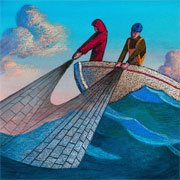The business of making loans to poor people in underdeveloped countries is itself entering a critical period of development, according to panelists at this year’s Wharton Finance Conference.
On one hand, they said, foundations and other non-governmental groups have shown the private sector that there is money to be made in lending to some of the globe’s poorest populations. And, they acknowledge, only the private sector has the capital to do this at the necessary scale. But they also warned, at the panel and in interviews afterward, that the drive for profit could leave behind some of the neediest citizens — particularly those in remote rural areas — and thus defeat the enterprise. Meanwhile, as an indication that microfinance is indeed on the global agenda, economist Muhammad Yunus, founder of Grameen Bank in Bangladesh, was awarded the Nobel Peace Prize on October 12.
The finance conference, “Creating Value in a Global Economy,” focused on the state of what moderator Keith Weigelt, Wharton management professor, jokingly called, “the good side of capitalism.”
A Brief History of Microfinance
Vinay Chawla, second secretary for economics at the U.S. Embassy in Jordan, described microfinance as “a relatively young industry even if it’s been around 30 years or so.” During the panel discussion and in a subsequent interview, Mariama Ashcroft, manager for policy and industry impact/Africa for Women’s World Banking (WWB), said that this short history can be broken into two phases, with the year 2000 as a rough dividing point.
Into the 1990s, she said, “the NGOs (non-governmental organizations) were doing [microfinance] primarily as a social mission … supported by donors and heavily subsidized by grants.” The only purely commercial enterprise involved was the Grameen Bank in Bangladesh, operating under a special charter from the government.
But since 2000, said Ashcroft, “institutional lending has grown tremendously. Now it is the method of delivering credit to poor people. This is a huge shift in paradigm [with] both positive and negative effects. You have more loans going to poor people on the ground, helping them build more profitable businesses.” In addition, “some of these large global institutions are now more willing to share their expertise…. On the flip side, you have institutions being pressured to make a profit … moving up-market to the not-so-poor, the people with collateral, for better security.”
Although reliable statistics are hard to come by, there is evidence at all levels that microfinance is growing dramatically. As of the end of 2004, according to the Microcredit Summit Campaign Report, more than 3,000 microcredit institutions reported reaching over 92 million clients, two thirds of whom “were among the poorest when they received their first loan.” (Microfinance includes microcredit as well as other related services such as insurance and savings accounts.) In addition, there has been a sharp increase in institutions — such as New York-based WWB — that advise microfinance agencies. CitiBank is partnering with WWB to train microfinance institution managers.
The United Nations General Assembly designated 2005 as the International Year of Microcredit. Meanwhile, interest in the topic is growing in the United States. Weigelt noted that the microfinance curriculum at Wharton started as “a student-driven initiative three years ago.” The key question, said Weigelt, is: “How do you stick to ‘the double bottom line?'” — profitability and social responsibility.
Panelists offered a series of suggestions for strengthening microfinance, including greater transparency and efficiency in banking systems world wide; more sophisticated use of technology down to the village level; and beefing up regulations to see that abusive practices from the developed world do not take root in the developing world.
Forget Room Service
In addition, panelists heard another, very traditional suggestion not limited to microfinance: Getting the right people in the right places. Human capital in this area “is a tremendous challenge,” said Andree Simon, assistant director to the executive office at FINCA, the Foundation for International Community Assistance, an international network of MFIs (microfinance institutions) with 450,000 clients and $130 million in loan portfolios.
“There are just not a lot of people with the background to work in rural areas,” she said. “You can’t take commercial bankers and drop-kick them into the Congo. There are not a lot of people willing to work in Kabul. It means going into places that make your hair stand on end. You can’t be worried about room service.”
Chawla provided the clearest example of technological innovation, describing his work at the village level in India. In 2000, before joining the Foreign Service, he took a leave from his job in the private sector to work with Swayam Krishi Sangam (SKS), a Grameen Bank replicator in South India. With SKS, he led a project to develop a smart card loan repayment system that earned the organization and its CEO a 2006 TIME Top 100 award. “I always talk about technology as the pillar of efficiency,” he said. “Instead of a village meeting taking an hour, it took a half hour. And it cut our costs in half.”
MFIs “need a robust technical platform,” said Simon, and they will need to develop more sophisticated technologies “to support the back office. The ability to reach out into rural areas will be the key to success in microfinance in the coming years.” Such outreach is particularly difficult for commercial lenders, Ashcroft said, because it is in the rural areas that services can be hardest to provide. In Africa, she noted, a bank seeking to cut costs in a soft economic climate is most likely to look at cutting branches in the rural areas.
Nontheless, she said, lending by commercial banks and MFIs at the lowest levels has moved from groups, such as village cooperatives, to individuals. And loan sizes are increasing to the point where they can have more significant impact. “Many institutions are also providing micro-insurance. We’re seeing loans for education … loans requiring a cash-flow appraisal. We’re seeing loans to build houses instead of home improvement. I believe it’s a change for the better. But there will still need to be group lending.” She expressed doubt that any lender “can do appropriate risk analysis at the rural level.”
Ashcroft, who is from Gambia, is also concerned that loans to increase trade could actually hurt small farmers in Africa by subsidizing agricultural imports that would compete with them.
Abusive Collection Practices
Panelists cited other indications that the microfinance playing field operates at different levels in different areas. Ashcroft noted that individual lending took root in Latin America in the 1990s, well before it became common in other areas. She said that Bancosol of Bolivia became the first commercially regulated bank to convert itself from a NGO. In contrast, according to Weigelt, banks in the Middle East “often have absolutely no mechanism to assess risk and this makes them more dependent on subsidies.”
In Haiti, added Simon, there is no national ID system and thus no traditional way to track clients who might want to get multiple loans from different agencies. “You had to take someone’s word for who they were.” In response, MFIs developed their own ID system “to prevent double dipping.” But, she said, there needed to be more emphasis on developing credit bureaus worldwide.
Some panel members also cited another tough decision for agencies supporting microfinance: Should they concentrate on the larger institutions with greater power to leverage capital right now, or devote more resources and attention to smaller banks and MFIs to get more players into the game? “Do we want to focus on the top tiers to take them to the next level” or work on the levels slightly below, asked the Grameen Foundation’s Shannjit Singh. There is “no easy answer,” he added. Singh is a financial analyst with the Foundation’s Growth Guarantees Program, a $31 million loan guarantee initiative that helps high-growth microfinance institutions around the world secure competitive financing from local and international commercial banks.
Ashcroft proposed more support for the smaller players. “We need to start looking away from [just] these big organizations,” she said. “There are small institutions that are struggling but have a very high potential.” Singh cautioned that there would still need to be a flow of grant money to “the new startups that are very risky.” And Simon called for even more sources of capital. “There are 9,000 hedge funds in the world,” she said. “We (in microfinance) are still a really small movement.”
She and other panelists emphasized the need to make sure that the expansion of microfinance did not obscure its social mission. “I’m suspicious of commercial banks coming into microfinance and making small loans,” said Simone Balch, a vice president at Developing World Markets, an investment bank involved only in socially dedicated projects. Linking MFIs to capital markets, the bank has raised $250 million throughout the world.
Ashcroft expressed similar concerns. “We see large institutions say they are going to do microfinance and what they’re actually doing is consumer lending at very high costs,” she said. “They are pushing these loans on clients … and using methods of collection that are abusive…. We need commercial banks to participate in microfinance both as wholesalers and as retailers. It’s the only way we can make a dent in the huge level of poverty in the world.” But, she added, “we have to do it well and do it responsibly.”
In Latin America, according to Simon, there has been particular concern about over-indebtedness. She said this “is as bad for the MFIs as it is for the clients …. It means [a need for] more due diligence on the clients and their backgrounds.”
Commercial enterprises, she added, are becoming increasingly eager to form partnerships with microfinance institutions that already have an established client base. But “you have to be careful about the people you partner with.” Acknowledging that making a profit and being sustainable are clearly important goals, she also noted that “the real reason we are in this business is to help people out of poverty. It’s going to be in our best interests as businesses to provide additional services to our clients…. The economist in me wants to say that if the clients are coming to you, it’s because you are providing something that is of value to them. The social activist in me wants to be able to say, ‘We’re on mission.'”



